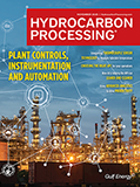Environment & Safety
Reboiler pinch: An approach to optimize flare system design during FEED
A process plant’s pressure relief and flare systems are critical safety elements.
Achieve process safety, asset integrity and reliability with an integrated HAZOP study
Abnormal situations in refining and petrochemical plant operations can interfere with plant reliability and efficient operations, especially for highly complex processes.
Optimize flare gas recovery system design to reduce emissions
Emissions from flares worsen air quality and produce waste gas. A flare gas recovery system is designed to facilitate CO<sub>2</sub> reduction.
Protect your assets and our environment
Process cooling usually comprises the largest part of the water footprint of a refinery or petrochemical plant.
FTO: An enabling emission control technology for petrochemical plant expansions
For the petrochemical industry, the U.S. Gulf Coast (USGC) has the locational advantage of proximity to cheap feedstock, and to an abundance of pipeline infrastructure and terminals for export markets.
Safety: Addressing corrosion at petrochemical plants starts with carbon
Maintaining the structural integrity of a pipeline is a significant investment of time and resources for organizations in the oil and gas industry.
Safety: Strategic considerations in contemporary process safety management
During this unprecedented industry crisis spurred by the COVID-19 pandemic, the process industry’s response has been multi-faceted, showing its generosity and humanitarian side, as well as its collective resilience to an environment filled with formidable challenges.
Maintenance: Zero-based, custom-built, reliability-driven—A new kind of maintenance organization
In the October 2018 issue of <i>Hydrocarbon Processing</i>, the authors published an article—“Improving plant performance by changing a maintenance culture”—describing the first two years of Eastman Chemical Co.’s Longview, Texas site’s journey to maintenance excellence, which began in 2016.
Business Trends: Autonomous operations in process manufacturing—Part 2
The purpose of this article is to demonstrate an autonomous operations (AO) vision, along with its feasibility, by conceptualizing a roadmap where meaningful progress can be achieved in a horizon of 3 yr–20 yr.
Industry Perspective: IRPC Americas ONLINE: A sincere thanks
Each year, <i>Hydrocarbon Processing</i> hosts events to bring together professionals in the oil and gas industry to share ideas and knowledge on the latest advancements in processing technologies and operations.

- UPM unlocks new bio-based markets as Leuna biorefinery produces its first commercial product 12/19
- Stamicarbon awarded technology licensing contract for new urea plant in Eastern China 12/19
- Ford takes $19.5-B writedown on EV business 12/19
- Babcock & Wilcox awarded $40-MM contract for advanced wet gas scrubbing technology at Canadian petroleum refinery 12/19
- Aarti Industries secures methanol and toluene feedstock supply through multiple long-term contracts 12/19
- bp picks first outsider CEO Meg O'Neill after abrupt Auchincloss exit 12/19




